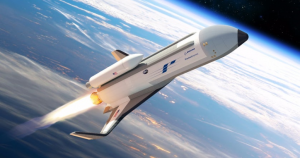DARPA’s ambitious launch-a-day spaceplane is a step closer to lift off after Boeing announced that it’s been assigned the contract to work with the agency to design, build and test a technology demonstration vehicle for the Experimental Spaceplane (XS-1) program. Called the Phantom Express, the goal is to create an unmanned, autonomous, hypersonic, reusable spaceplane that can deliver small payloads of 3,000 lb (1,361 kg) to low Earth orbit.
Currently, space launches are special events that take months or years in preparation, but as the world becomes more dependent on orbital assets, stepping up the pace is becoming a major priority. This is especially the case for the military, which often requires new satellites put in place on very short notice to fulfill missions in a fast-changing world.
The Phantom Express is DARPA’s idea for a craft that can deliver small payloads into orbit for about US$5 million each. Unlike the US Air Force’s X-37B, the Phantom is a self-contained vertical launch vehicle about the size of a business jet and uses cryogenic liquid oxygen and hydrogen propellants to power an updated version of the Space Shuttle’s Aerojet Rocketdyne AR-22 engine.
The idea is that the Phantom Express would lift off from a launch pad and go into a suborbital trajectory at hypersonic speeds while shielded by third-generation thermal protection. After it reaches the edge of space, it would launch a small, expendable second stage, which would deliver the payload to orbit. Meanwhile, the Phantom would bank and return to the spaceport, where it would land like a conventional aircraft.
Because the Phantom would be built and operated more like a military aircraft than a space vehicle, and even uses off-shelf military components, DARPA says that it has a potential turnaround time for the next launch of hours instead of weeks. According to the agency, this first of a new class of spaceplanes would allow the US to quickly recover even if faced with the catastrophic loss of military or commercial satellites.
Boeing’s task is to develop a technology demonstrator capable of carrying out 10 flights in 10 days by using easily accessible subsystem components that can be quickly ordered and replaced.
As the XS-1 project enters Phase 2 and 3, the vehicle will incorporate advanced, lightweight composite cryogenic propellant tanks, hybrid composite-metallic wings and control surfaces capable of withstanding hypersonic temperatures and stresses, and automated flight-termination and other technologies, including those from DARPA’s Airborne Launch Assist Space Access (ALASA) program.
If all goes to schedule, Phase 2 will see static engine tests by 2019, followed by Phase 3 that will include 12 to 15 flight tests by 2020, the 10 in 10 days flight demonstration, and hypersonic test flights at Mach 5 (3,800 mph, 6,125 km/h). This will be followed by flights at Mach 10 (7,600 mph, 12,250 km/h) and delivering payloads of up to 3,000 lb (1,361 kg) to low Earth orbit.
DARPA says that in addition to the Phantom Express helping meet military needs, it hopes it will attract interest in the XS-1 technology from private firms.
“The XS-1 would be neither a traditional airplane nor a conventional launch vehicle but rather a combination of the two, with the goal of lowering launch costs by a factor of ten and replacing today’s frustratingly long wait time with launch on demand,” says Jess Sponable, DARPA program manager. “We’re very pleased with Boeing’s progress on the XS-1 through Phase 1 of the program and look forward to continuing our close collaboration in this newly funded progression to Phases 2 and 3 — fabrication and flight.”
The animation below shows the Phantom Express in action.
Source: newatlas.com
Ask me anything
Explore related questions







